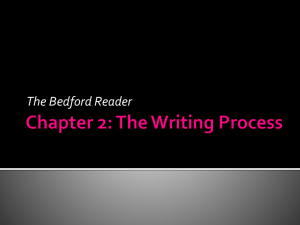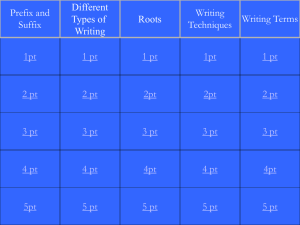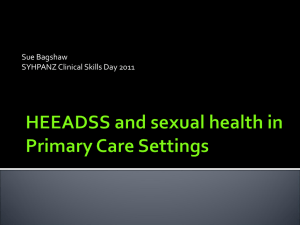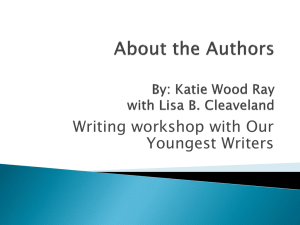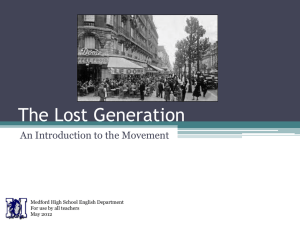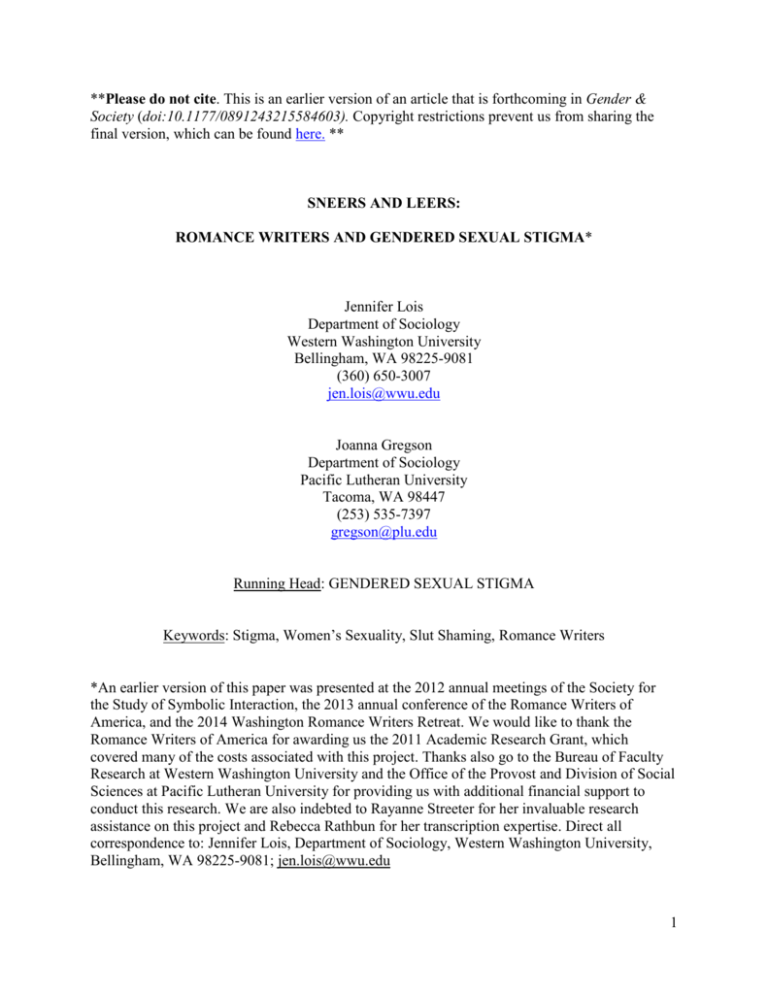
**Please do not cite. This is an earlier version of an article that is forthcoming in Gender &
Society (doi:10.1177/0891243215584603). Copyright restrictions prevent us from sharing the
final version, which can be found here. **
SNEERS AND LEERS:
ROMANCE WRITERS AND GENDERED SEXUAL STIGMA*
Jennifer Lois
Department of Sociology
Western Washington University
Bellingham, WA 98225-9081
(360) 650-3007
jen.lois@wwu.edu
Joanna Gregson
Department of Sociology
Pacific Lutheran University
Tacoma, WA 98447
(253) 535-7397
gregson@plu.edu
Running Head: GENDERED SEXUAL STIGMA
Keywords: Stigma, Women’s Sexuality, Slut Shaming, Romance Writers
*An earlier version of this paper was presented at the 2012 annual meetings of the Society for
the Study of Symbolic Interaction, the 2013 annual conference of the Romance Writers of
America, and the 2014 Washington Romance Writers Retreat. We would like to thank the
Romance Writers of America for awarding us the 2011 Academic Research Grant, which
covered many of the costs associated with this project. Thanks also go to the Bureau of Faculty
Research at Western Washington University and the Office of the Provost and Division of Social
Sciences at Pacific Lutheran University for providing us with additional financial support to
conduct this research. We are also indebted to Rayanne Streeter for her invaluable research
assistance on this project and Rebecca Rathbun for her transcription expertise. Direct all
correspondence to: Jennifer Lois, Department of Sociology, Western Washington University,
Bellingham, WA 98225-9081; jen.lois@wwu.edu
1
ABSTRACT
Drawing on four years of ethnographic research with romance novel writers, we show
how their affiliation with romance—a literary genre known for stories containing sexual
content—prompted outsiders to sexually stigmatize them. Our work examines both the
application and management of this stigma. We describe how outsiders applied the stigma in two
ways: by conveying blatant disapproval through “sneering” and inviting writers to display a
highly sexualized self through “leering.” Writers interpreted outsiders’ sneering as slut-shaming
rhetoric and responded discursively to manage the stigma; leering, however, sent a more
complicated message which was harder for writers to manage. In revealing how these
interactions threatened to strip writers of their sexual agency, our analysis suggests gender may
be a primary mechanism by which stigma is applied and managed, which has theoretical
implications for the stigmatization of women’s sexual selves.
Keywords: Stigma, Women’s Sexuality, Slut Shaming, Romance Writers
2
SNEERS AND LEERS:
ROMANCE WRITERS AND GENDERED SEXUAL STIGMA
Women’s bodies are often viewed as unclean, overly sexual, and are subject to double
standards when compared to men’s sexualized bodies and activities (e.g., Armstrong et al. 2014;
Crawford and Popp 2003; Nack 2008). Likewise, restrictive sexuality norms are the primary
means of evaluating and attempting to assert social control over women (Stein 2006). As a result,
sexuality remains an extremely potent source of stigma for women. Drawing on four years of
ethnographic research with (mostly) female romance novel writers in the U.S., we show how
writers’ affiliation with romance—a literary genre known for stories containing sexual content—
prompted those unaffiliated with the genre (“outsiders”) to sexually stigmatize them. Our
analysis reveals that outsiders applied the stigma in two ways, both of which, writers believed,
hinged on the misperception that writers lacked the appropriate amount of shame toward
women’s sexuality. The different ways outsiders applied the sexual stigma shaped writers’
ability to respond to these misunderstandings of romance novels and the women who write them.
As the most widely read genre in commercial fiction, romance constitutes the largest
market share, and as such provides revenue that subsidizes publishing houses’ other genres such
as other commercial fiction, literary fiction, and non-fiction, all of which generate less profit
(RWA 2013; see also Regis 2003). Scholarship on romance fiction has disproportionately
focused on the content, with literary scholars performing close readings (e.g., Selinger 2012),
social scientists analyzing the gendered and sexual messages (e.g., Clawson 2005), and cultural
critics asserting the narratives disempower (e.g., Radway 1984) or empower (e.g., Regis 2003)
readers.
3
Despite its immense popularity with readers, as well as a wide range of writing styles,
plot complexities, and degrees of sensuality, romance remains “the most popular, least respected
literary genre” (Regis 2003, xi). The novels are consistently disparaged, ridiculed as “bodice
rippers,” and presumed to be formulaic, full of “purple prose,” and only read (and written) by
bored housewives (Regis 2003). A small subset of research has focused on readers’ experiences
with the stigma, showing they hide their reading activity from family (Puri 1997), use book
covers in public (Brackett 2000), are quick to explain the educational benefit of romance
(Brackett 2000; Puri 1997), and regularly defend their ability to distinguish fantasy from reality
(Brackett 2000; Puri 1997; Radway 1984). The stigma of the sexual content also affects readers:
they are acutely aware that romances are “trashy” (Puri 1997) and know they risk being labeled
“as people who either don’t have a love life or are nymphomaniacs” (Brackett 2000, 356).
Readers experience the stigma, yet no research has addressed how the sexual stigma affects
writers.
Because sexuality is so salient in how people define women and judge their behavior,
sociologists have examined the many ways sexual stigma creates complicated identity issues for
women. For example, Wilkins (2008) explored how young Christian women embraced
abstinence to manage their previous sexual “sins” and forge moral identities based on feminine
sexual purity, while Nack (2008) investigated how women with sexually transmitted diseases
defined themselves as “damaged” romantic partners. Numerous studies have revealed the sexual
degradation and harassment male customers routinely aim at female dancers—both strippers
(e.g., Barton 2002) and belly dancers (e.g., Kraus 2010)—as well as the ways dancers hide their
stigmatized occupations from people in their conventional circles (e.g., Kraus 2010; Trautner and
Collett 2010). Even survivors of sexual violence struggle to mitigate the impact to their
4
identities, a task hindered by the bias in the criminal justice system and cultural ideas of gender
that cast victims as “asking for it” (Weiss 2010). The romance writers in our study discussed the
challenges of managing the sexual stigma outsiders imposed on them, which writers understood
as attempts to sexually shame them.
In his analysis of stigma, Goffman saw shame as a logical emotional result: when the
stigmatized realize they “fall short of what [they] really ought to be….[s]hame becomes a central
possibility” (1963b, 7).1 People manage information about themselves to avoid, minimize, or
neutralize the shame associated with their stigmatized identities. Goffman claimed that shame is
a key mechanism of social control because people keep their self-presentations within the bounds
of polite society to avoid feeling it. Furthermore, people may actively display shame to show
others they understand their stigma is wrong. Shame, then, is a normative emotion because it
demonstrates stigmatized people’s “appropriate” feelings toward their own deviance (Goffman
1963b; see also Scheff 2003).
Shame as an affective state, however, is different from the interactional dynamic in which
one person may engage in shaming as “a means of eliciting shame [in another] through moral
righteousness and judgementalism” (Gould 2009, 384). In this sense, to shame others is an
attempt at “interpersonal emotion management” (Francis 1994); shamers want targets to
internalize the moral inferiority of their stigma and the affective shame associated with it.
Targets may yield to these shaming efforts or employ a host of strategies to resist, which makes
the shaming process a rich case for an interactional analysis of stigma management and identity
negotiation. Although both shame and shaming are central features of the stigma process, they
remain underexamined in stigma theory (see Scheff 2003). In the case of women’s stigmatized
5
sexuality, this seems a significant oversight given the immense cultural shame and targeted
shaming associated with it (see Stein 2006).
Shaming women for their sexual transgressions is colloquially known as “slut shaming,”
a practice with roots in the double standards for women’s and men’s sexual agency and
experience (Crawford and Popp 2003). Armstrong et al. (2014) examined slut shaming in detail,
focusing on how upper-middle-class women at a U.S. university used “slut-shaming discourse”
to label their own sexual behavior as “classy” and that of their working class peers as “trashy.”
Similarly, Ringrose et al. (2013) documented how teenage girls in the United Kingdom who sent
sexually explicit text messages to boys were slut shamed, whereas boys were not. As with
research on victims of sexual assault (e.g., Weiss 2010), these findings support the notion that
women’s sexuality is laden with shame; women are made to feel shame for having sexual
experiences and desires, even if the encounters are unwanted or the allegations of promiscuity
are unfounded. While the concept of slut shaming is typically used in relation to adolescent and
college-aged women (e.g. Armstrong et al. 2014; Ringrose et al. 2013), we argue that it has
implications for the adult romance writers we studied insofar as one source of the stigma cast
upon them was their transgressive sexual agency in writing sexually explicit material. Exploring
outsiders’ slut-shaming messages emphasizes the importance of stigma application, a conceptual
focus less common in the research on stigma, which disproportionately focuses on how targets
manage the stigma (Armstrong et al. 2014; [Author YEAR]).
As we explored how slut stigma was applied to writers, it became clear that it shaped the
ways they could respond, a facet of slut shaming about which we were equally curious. The few
extant studies specifically addressing slut shaming highlight how women try to manage the label
(e.g., Ringrose and Renold 2012) or how the application and management of sexual stigma work
6
in tandem and thus cannot be separated (Armstrong et al. 2014). Yet none have addressed these
two elements of the stigma process as analytically distinct but related interactional dynamics. If
women’s sexuality is shamed in various ways (e.g., Crawford and Popp 2003; Stein 2006; Weiss
2010), and if women manage sexual stigma (and its inherent shame) differently (e.g. Kraus 2010;
Nack 2008; Trautner and Collett 2010), it stands to reason that stigma application and
management may be contextually related: how a stigma is successfully managed may depend on
how it is applied. Our research reveals how romance writers’ ability to manage slut shaming was
shaped by the ways outsiders stigmatized them during specific interactions, an analytical angle
that deepens our understanding of the dynamics of stigmatization and the emotional shaming
process therein.
In the next section, we discuss the setting we studied and the data collection methods we
used. We then show that writers understood outsiders’ stigmatization as either “sneering” or
“leering,” and we examine how these forms of stigma attribution influenced writers’ efforts to
manage the sexual stigma. We conclude by discussing two ways slut shaming may occur and
consider the theoretical implications for stigma theory and women’s sexuality.
SETTING AND METHOD
Our research began in 2009, when the popularity of the Twilight (Meyer 2005) youngadult series sparked our interest in a fiction genre that was new territory for us. We began
reading romance in our leisure time, passing novels to each other, and discussing our favorite
authors. In visiting their websites, we discovered a great deal of advice on how to write
commercial fiction (as opposed to literary fiction)2, as well as many references to the Romance
Writers of America (RWA), the national professional trade organization for both published and
7
aspiring romance writers. As a creative release, we tried our hands at writing fiction and began
attending the monthly meetings of a local RWA chapter in the Pacific Northwest, where we met
dozens of romance writers and learned about their typical career trajectories, the commercial
publishing industry, and the craft of writing. Our sociological interest quickly prevailed over our
talents in creative writing, and we began our research in earnest in spring of 2010.
To be considered a “romance,” a novel must meet two criteria: a love story must be the
central focus, and it must have what writers call an “HEA”: a Happily Ever After. Though
romance novels are stereotyped as highly sexual, the genre is diverse. Some books include highly
explicit sexual content, such as the well-known Fifty Shades of Grey (James 2011), whereas
others “close the door” on their characters’ sexual activity. These “sweet” romances can appear
in any subgenre (except erotic romance), but are most common in Christian romances, where
publishers prohibit sex before marriage and instruct authors to “keep it above the neck.”
However, sweet romances are the minority in the industry, as most writers do include sexual
content.
The romance writing community is 99% female and largely white, though all races are
represented. Romance writers’ socio-economic statuses and education levels vary widely; we
met just as many women who did not attend college as those with graduate degrees. Of the
10,000 members of RWA, only the minority are published through traditional publishing houses
(many more are now self-publishing) and even fewer have full-time careers writing romance. A
large publishing house typically offers an author with modest sales (a “midlist” author) only a
few thousand dollars cash advance on a book’s royalties. A small number of “bestselling”
authors earn six-figure advances (very rarely more). Given the limited earning potential as an
8
author, the majority of romance writers hold day jobs. As 40-something, white women who did
not earn a living writing romance, we fit in easily.
For four years, we attended our local monthly meetings, eight national- and regional
romance writing conferences, one national romance-reader convention, and several local author
events. We joined two romance-writer listservs, perused hundreds of writers’ websites, followed
writers on Facebook and Twitter, and between us read over 300 romance novels. We also
participated in the subculture by trying to write romance novels ourselves, which gave us a sense
of how difficult it is to plot a story, develop character arcs, and infuse dialogue with subtext. We
recorded our observations in detailed field notes and copied thought-provoking online content to
electronic files, ultimately amassing several hundred pages of field-note data. Through this
“complete membership role” (Adler and Adler 1987), we gained “intimate familiarity” (Blumer
1969) with the subculture of romance writers.
In addition to collecting observational data, we also conducted in-depth interviews with
writers and other industry professionals, focusing the questions loosely around entry into the
genre, career trajectories, and experiences with the subculture of writers. We both took part in
every interview, generally with one writer, although occasionally we interviewed groups of two
or three. Our interview sample consisted of 43 writers from all subgenres (e.g. historical
romance, romantic suspense, LGBT romance), ranging from unpublished writers working on
their first manuscripts to New York Times bestselling authors, and every level in between.
Though heterosexual white women make up the majority of the romance-writing population, we
interviewed 3 male writers, 11 writers of color, and 2 lesbian-identified authors to cover the
range of experiences that may be influenced by these categories. We also interviewed 12 other
industry professionals (2 of whom were men), such as editors, agents, reviewers, and publicists
9
to get their perspective on the writer subculture. Interviewees’ ages ranged from 20s to 70s,
though most were in their 40s, and they hailed from all over the United States (2 from overseas).
All interviews were recorded and transcribed.
As we analyzed our data, we began to see patterns forming around salient topics, or
“sensitizing concepts” (Blumer 1969), such as the sexual stigma of the genre. We recorded these
emerging patterns, formed tentative theories to explain them, and probed deeper into those issues
during subsequent interviews and observations. In some cases new data supported our analysis;
in others they countered it, forcing us to reformulate our conceptual framework. This process of
shifting between inductive and deductive reasoning made the data gathering and analysis
interactive and dialectical, a practice in line with Glaser and Strauss’s (1967) model of grounded
theory. We continued until we reached “theoretical saturation” (Glaser and Strauss 1967) and no
new patterns emerged from the data.
ROMANCE WRITERS AND GENDERED SEXUAL STIGMA
Outsiders often made comments to writers that suggested they viewed them as oversexed
women who documented personal sexual experiences and fantasies in their books. Writers
believed these comments were driven by the stigma of the genre, which is known for containing
sexual content. While some writers avoided the stigma by excluding sexual content, most writers
confronted the stigma and had to engage it. When writers described these interactions, and when
we witnessed them ourselves, we noted that outsiders reacted to the sexual content of romance
fiction by either sneering in disapproval or leering in mock “approval.” These two forms of
stigma application required writers to employ distinct techniques to manage the sexual stigma of
romance writing.
10
SNEERING DISAPPROVAL
Our interview and field-note data contained many examples of outsiders showing their
disrespect for romance writers because of the sexual content in their books, a reaction several
writers labeled a “sneer.” Our data suggest that these sneers constituted “shaming messages,”
communicating to writers that they did not feel the “appropriate” level of shame around women’s
sexuality. Writers responded by refuting the idea that women’s sexuality is shameful.
Outsiders’ Shaming Messages
Outsiders often expressed their disapproval of romance novels by referring to the books
as “porn for women” and describing them as “dirty,” “smutty,” and “trashy.” We heard scores of
these descriptions first-hand, both in spending time with writers as well as in discussing our
research with those outside the romance world. For example, at the height of Fifty Shades of
Grey’s popularity, a major news network ran a “mommy porn” story (reposted online), featuring
a “76-year-old grandmother” who had written over 140 erotic romance novels. Viewers reacted
strongly to the segment, posting comments shaming the news story’s sexual content: “Shame on
you [network]…And shame on those viewers who are supporting this story and imposing their
filth on the rest of us.” Other comments described the broadcast as “disgust[ing],” signaling the
“moral decay of America,” and calling the author a “pervert” who “has chosen to step into a
cesspool of porn....[This] pathetic old woman must be trying hard to remember what she never
had. How embarrassing for her family.”
These reactions were not unusual. When we asked writers about the sexual stigma of
romance, we heard dozens of stories that confirmed our observations. Karen (pseudonyms used
throughout) explained, “When I talk to my friends, it’s just disparaging: it’s ‘smutty,’ it’s all
11
those clichés of it being ‘dirty,’ and [they ask] ‘why would you write about sex?’” Sonja told us
that outsiders say, “‘Oh, you write those books; those ‘slutty little romance’ books.” Writers took
outsiders’ disparagement personally; when the books were described as “smutty” and “slutty,”
writers felt labeled that way, too.
One source of this stigma stemmed from the cultural imperative to keep sex private.
Outsiders seemed to believe that romance authors documented their personal sexual experiences
and fantasies. Julie, a bestselling author, explained how her mother reacted to her work:
My mother is horrified by what I write because of the sex in it. She’s horrified. I say, “Mom,
you always raised me to have a healthy appreciation for sex, and that it is a beautiful thing
between two people who love each other.” And she says [in snippy voice], “Yes, but you
don’t do it on the street.” And that’s the way she sees it, that I’m doing it on the street for
everybody to see.
In her mother’s view, the sexual encounters between Julie’s characters equated to Julie herself
violating this norm of sexual privacy and “doing it on the street.” Though Julie questioned her
mother’s disapproval, her mother shamed her for publicizing her sexuality, a common reason
women labeled each other “sluts” in Armstrong et al.’s (2014) research.
Moreover, Julie’s mother denigrated the books, and by extension Julie herself, to others.
Julie recounted an instance when she was standing with her mother, who “told one of her friends
[quietly], ‘You know [Julie’s books] have sex in them.’ And [the friend] said, ‘Yes, I skip those
parts.’ And I thought, ‘The hell you do.’” These kinds of stories illustrated how outsiders applied
the “slut stigma” (Armstrong et al. 2014) to writers and discursively shamed them, not only for
their perceived deviant sexual behavior but also for their presumed emotionally deviant
orientations around sexuality. If the goal of slut shaming is to induce sexual shame, the implicit
12
message is that the shamer believes the target is violating a “feeling rule” (Hochschild 1983) by
not having enough shame around sexuality. Writers felt this message in their sneering
interactions with outsiders.
Whether outsiders’ slut shaming was intentional or not, it was so common that writers
braced themselves when conversations turned toward the topic of their writing. Denise, who had
published two books with a small press, and Cheryl, still unpublished, explained the reactions
they got from outsiders:
Denise: The second you tell someone [you’re a writer], then they want to know what you
write. And if you say “romance,” well, you know—
Cheryl: —they automatically think you write something that verges on porn….I think a big
issue for all [romance writers], a common theme, is the shame people associate with it.
Slut-shaming messages were often effective. Several writers told us about their own
feelings of shame early in their careers and often (but certainly not always) regarding highly
erotic content. For example, a new member to our writers’ group discussed these feelings when
she introduced herself over email:
No one I know will even *admit* to reading romance, or <blushes> erotica. And *I* write
the stuff, so what does that make me?...Others might consider me pond scum for some of the
stuff I…dare put into words! Can’t wait to meet some others who…dare to put into words
what others might only read under the covers in the dark.
The more erotic the sexual content, the more cause for shame, and the more need for writers to
find others who could help them refute mainstream culture’s shaming messages.
In spite of the shaming messages, most writers we talked to did not feel shame about the
sexual content of their books. They discussed the work it had taken to reach that emotional state,
13
to “mostly—mostly—kill the self-conscious voice inside,” as one writer explained. Vicki, a 25year veteran, told us it took time to overcome the vestiges of shame associated with romance: “I
finally had that light-bulb moment thinking, ‘There is no shame in what I do and, in fact, I
should be incredibly proud.’” Many writers credited the great support they received from others
in the romance community who taught them how to contest the sneering shame they felt
outsiders unfairly applied to them.
Contesting Shame
Since shaming messages seemed aimed at encouraging writers to feel more shame, the
primary message in sneering was that writers were sexually shame-deficient. As such, their
stigma-management technique of choice was pointing to the misplaced shame around sexuality.
As the antithesis of shame, pride (see Gould 2009; Scheff 2003) was one way to neutralize the
slut-shaming discourse. For example, in an email listserv debate over the presence of a film crew
at an upcoming romance-writer conference, one writer expressed concern about being captured
on film and “outed” to work colleagues as an erotic romance author. Another writer responded
with her opposing views:
I’m tired of romance writers not taking pride in their writing….If you risk your day job by
the work you write, that’s an issue you stepped right into [that you] need to…remedy by
either changing your day job or the genre you write. By not stepping forward and proudly
proclaiming [that] we write the most popular genre of fiction, we are only helping to
perpetuate the “it’s dirty” attitude of ignorant people.
Developing a more critical stance toward the broader cultural shame associated with sex allowed
writers to contest the shame-deficient identities they felt outsiders applied to them.
14
Though showing pride was effective, writers’ realization that sexual shame is
disproportionately aimed at women significantly strengthened their ability to contest it. One
author of erotic romance explained on a website how she tried to handle shaming messages from
outsiders:
So many of my author colleagues are…proud to announce that you write erotic romance…
and damn, do I envy you.…You don’t qualify the statement by [labeling your work] “trashy”
or “smut” or “porn.”…I don’t want to qualify what I write when asked.…I need to stop
preemptively apologizing. Because beneath that puritanical bullshit is a woman who is damn
proud of what she does….[A]s a feminist, I am not inwardly ashamed at all, and if someone
takes it upon themselves to try to make me feel uncomfortable, that speaks to their character,
not mine.
This author, like many others we talked to, understood outsiders’ shaming messages as attempts
at interpersonal emotion management—they were “try[ing] to make [her] feel uncomfortable”
for including sexual content in her stories. Recognizing the gendered component of what she saw
as shaming attempts helped this author resist the misplaced cultural shame around women’s
sexuality. Similarly, a bestselling romance author who also worked as a professor of English
literature defended the genre in an op-ed to the New York Times (2005), writing, “Clearly the
genre’s struggle for respect is part of a larger cultural battle to define and control female
sexuality.”
Other authors also believed that the denigration of romance is connected to the culture’s
suppression of women’s—but not men’s—sexual desire. Adrienne, a bestselling author,
appreciated the power of romance novels to reclaim control over female sexuality:
15
It all comes back to the same kind of basic beliefs: Women shouldn’t be sexual….It used to
be that when [literary authors] wrote about unmarried women having sex, they’d always die
in the end. Women who had sex—that was not nice, neat, little married sex—would be
killed. That was your punishment, Woman, for being a sexual creature. And I appreciate
taking that back….The message that romance gives is that it’s good for women to celebrate
their sexuality. It’s really okay to enjoy sex; you shouldn’t just lie on your back and think of
England, or whatever we were told to do!
Understanding that romance’s sexual stigma came from deep-seated, patriarchal values helped
writers contest the shame they felt outsiders tried to impose on them and fight the sneering
disapproval. As one writer remarked in a public presentation we gave on our developing
findings, “Romance triggers people’s fears of women’s sexuality, and they react by slut
shaming.”
Interestingly, the male romance writers in our sample experienced the sexual stigma of
romance differently. As a “women’s” topic, romance called their masculinity into question.
Unlike female writers, male writers rarely encountered outsiders deriding their shameful
sexuality; instead they perceived outsiders to be disparaging their shameful femininity, a deviant
emotional orientation that seemingly allowed them to write about love and relationships.
As a result, male writers managed the sneering stigma differently. One man, who had
self-published three romances, told us, “When I talk to males [about what I write], I never say
romance. Never. It’s sex.” Another male author explained that when outsiders tried to belittle
him, he used his power and size to combat the stigma of romance: “I have learned over the
[many] years I've been ‘out’ [as a romance writer]…that size matters….You cannot ever
underestimate the value of looking down on someone because you’re taller. They tend to be less
16
belligerent, less aggressive because you’re bigger than them, literally.” These examples reveal
men’s privilege in avowing their sexual agency and displaying their physical dominance, stigmamanagement strategies unavailable to women when confronted with the sneer of shameful
sexuality.
Ultimately, most female writers, no matter how hard they fought the slut-shaming
messages, resigned themselves to outsiders’ sneering. Deb, a lesbian-identified author of
male/male romance, explained, “I came out [as a lesbian] thirty years ago. I’m used to being the
redheaded stepchild. I’m sure it feels a lot worse to people who’ve moved from another genre or
never expected to feel that discrimination. But I’ve been around it for a long time.” For Deb, the
sexual stigma of romance writing—compounded by her own sexual identity and the eroticization
of her gay characters—was not surprising; she had learned long ago to disregard others’ shaming
messages. When we asked Deb to elaborate on how she withstood the relentless sneering, she
cited the amount of money she was making on her books. She and several other writers told us
they were “laughing all the way to the bank,” a conventional measure of success that offset some
of outsiders’ sneering. The more legitimate their writing careers, mostly measured by number of
books published and revenue earned, the more power writers had to contest the shame they felt
outsiders imposed upon them. That successful authors were able to respond in this way is
noteworthy; women in other sexually stigmatized occupations may also focus on their earnings
to cope with the stigma (e.g., Ronai and Cross 1998), whereas women whose employment is less
lucrative have a harder time resigning themselves to the sexualization they experience (e.g.,
Rogers and Henson 1997).
Moreover, writers’ career statuses further mediated the degree to which they could
manage the sneers. Those making a full-time living from their writing could quit their day jobs
17
and escape into the subculture of romance writers, where women’s sexuality was celebrated
rather than shamed. Yet most writers, who could not make a living writing, had to maintain their
conventional jobs where the normative emotional orientation toward women’s sexuality left
them vulnerable to outsiders’ blatant slut-shaming messages.
LEERING “APPROVAL”
The second way romance writers felt sexually stigmatized was through outsiders leering
at their willingness to write about sex. Our field-note and interview data were rife with these
kinds of interactions. Whereas sneering seemed aimed at discouraging writers’ shame-deficiency
through disapproving shaming messages, leering invited writers to play the part of the sexual
deviant by “approving” of their presumed willingness to share their sex lives and fantasies with
their readers. In these interactions, it appeared outsiders wanted to be voyeuristically entertained
by asking writers to play up the titillating aspects of their sexuality. Writers responded in two
ways: granting the request by personalizing their sexuality or denying it by depersonalizing the
sexual content of their books.
Outsiders’ Invitations for Sexualized Displays
We realized sneers and leers were conceptually distinct when one writer dichotomized
outsiders’ reactions, saying, “You get that leer, or you get the stuffy people who are like, ‘I don’t
read that type of stuff.’” Only a few months later, midlist author Trina told us a story that also
illuminated the difference between sneers and leers. As she made her foray into erotic romance,
she needed to do extensive research in order to write about erotic sexual activity. She told us she
arrived at a bookstore checkout stand carrying “all these books on bondage and BDSM” where
she encountered a “snooty bookseller.” She thought to herself, “Don’t judge me, I’m
18
researching!” She went on to explain that, in contrast, the man in line behind her gave her a
sexually suggestive smile, which led her to consider these different reactions: “I don’t know
what’s worse, the disapproval or the approval.” The customer’s leering approval stood in stark
contrast to the bookseller’s sneering disapproval. When leering outsiders treated writers as
though they were “open to sexual invitation,” as one author said, the interactions
overwhelmingly featured leering male outsiders propositioning female writers. We witnessed
these sexual advances several times, such as when a drunken male restaurant patron heard
romance writers were meeting in the banquet room and crashed our monthly workshop, making
suggestive comments to members.
Although these reactions appeared to be sexual propositions, we noted that leering
included a broader set of behaviors in which outsiders seemed to presume writers’ willingness to
share their personal sexuality by asking intrusive questions and engaging them in highly
sexualized conversations. For example, Trina described an occasion when a restaurant owner
agreed to help her with some research for one of her books. During their talk, Trina mentioned it
was a romance, which immediately transformed the interaction:
It was like the doors opened and next thing you know, she’s telling me all the restaurants
she’d worked at where people had sex on the bar….It was sort of like, “Oh you write about
sex. Well, let me tell you—”…It made me uncomfortable, but I just kept writing frantically
[laughs]….[When] I tell people I write romances, there’s a combination of humor and like,
“that’s so cool that you do something so weird and you get paid for it.” It’s not quite as bad
as stripping, but [people find it] kind of exciting. You can see the “[Gasp.] Oh. Wow. Good
for you.”
19
Writers’ affiliation with romance prompted outsiders to talk about sex with a surprising lack of
discretion—the very thing sneerers criticized writers for, leerers seemed to take as permission to
suspend norms around public sexuality. However, writers often felt an exploitive undercurrent in
these interactions. Trina’s discomfort with the restaurant owner was an emotional “marker” that
conveyed her lower “place” in the interaction (Clark 1997), which is clear from her comparison
to the stigma of exotic dancing.
In contrast to the straightforward slut-shaming messages involved in sneering, leering
was more complicated. Surface “approval” was undercut by veiled derision. For example,
although some commenters blatantly shamed the erotic-romance-writing-grandmother in the
network news story, a second group of commenters leered by saying, “I almost spit out my
coffee laughing!!!...We thought it was funny and interesting to see who is behind all that saucy
writing!” Another commenter thought the segment was “HILARIOUS!” and a third posted,
“Good on you, Granny….I’d bet she’s making money hand over fist. Hmmm, would that be [a
sexual act of] Granny fisting? lmao [laughing my ass off].” Cheryl, the unpublished writer,
pointed out this insinuation of stigma when she told us, “I love the [people] who think they’re
being very open and sexually progressive, and they say, ‘No judgment here!’…They don’t see
the irony.” The irony, of course, was that outsiders had to define writers as sexually deviant
before they could claim they would not judge them for it.
Writers also felt that outsiders fetishized their willingness to write about sex in even more
deeply personalized ways by asking if they had performed all of the sexual encounters described
in their books. Writers related countless stories of how, with a nudge and a wink, outsiders
asked, “How do you do your research?” and that their male partners often fielded comments such
20
as, “You must be really great [in bed]!” One author told us of her experience with this type of
leering when she participated in an interview on national television:
Elisa: [The interviewer asked] “Have you done all the things you write about in your books?
Do you watch a lot of porn? How’s your sex life?” Because romances are about sex,
people [wrongly] assume that’s open [for discussion] in my personal life.
[Author1]: So she was expecting you to say—what?
Elisa: “Oh my God, my husband’s got an eight-inch schlong!”
This type of prying into writers’ sex lives was constant. In discussing our research with various
audiences—scholars, lay people, students—we find that some outsiders don’t believe writers get
these questions so often. However, we collected scores of such examples, including instances
when outsiders asked us directly about our research: “How would E.L. James be able to write
Fifty Shades of Grey unless she’d tried all that kinky sex?”; “Romance writers have conferences?
What do they do at those?!”; and “Are romance writers more adventurous in the bedroom than
the rest of us?” These sexually titillating topics, often the first ones outsiders broached, reveal the
misconception that writers are sexual deviants who detail their autobiographical sexual
experiences and fantasies.
Leering made writers protective of their writers-only spaces. When our local chapter
debated the presence of a film crew at an upcoming conference, one writer emailed the group
explaining her experience at a previous event:
You know what the final newscast really looked like? “OMG! These crazy romance writers!
Shirtless men and mommy porn! How naughty they are! *giggle* *giggle* *wink* *wink.*”
My husband is in the computer field and goes to a lot of conferences. Strangely enough, news
organizations aren’t requesting to attend those conferences. Perhaps because there is no
21
salacious, giggly angle to exploit….I don’t particularly want to feel like part of a dog-andpony show.
Though not all writers in the group agreed with this woman’s position to ban the film crew, no
one denied that many outsiders view romance writers as a “salacious, giggly angle to exploit.”
Whereas sneering involved straightforward shaming messages, leering outsiders seemed
to define writers as “open persons” who could be “addressed at will” (Goffman 1963a, 126)
because they did not warrant the same respect as those who display “appropriate” shame around
sexuality. This lack of respect, though implicit, made leering interactions seem exploitive and
belittling. Writers felt outsiders fetishized their willingness to write about sex, asked them to
display their personal sexuality, and covertly cast them as shame-deficient.
Responding to the Invitation
When leering outsiders invited writers to display their sexualized selves, writers
responded in two ways: accepting the invitation by personalizing their sexuality or rejecting it by
depersonalizing the sexual content of their books.
Personalizing Sexuality. Some writers personalized their sexuality by playing along with
outsiders’ intimations that they were highly sexual women. Vicki, the best-selling author who
rejected shame earlier in her career, explained how she no longer corrected outsiders’
misconceptions about her personal sex life, preferring to yield to the “working consensus”
(Goffman 1959, 10) that she was highly sexualized:
People do make assumptions. They feel like if you write something, you must have done it. It
doesn’t bother me at all. If people think I’m…some world-renowned [sex] expert, that’s
fine….[My husband] just dies. He’s a very private person.…The last thing in the world he
22
would ever do is put any of his sexual thoughts or ideas out there in the world….So, I think
in a strange way it unnerves him that I am so comfortable with that. I am just out there.
Vicki did not correct outsiders’ assumptions that she was writing about her own experiences, but
she also acknowledged that it was a marked departure from how her husband felt. Just as Deb
resigned herself to the sneering she encountered because she was “laughing all the way to the
bank,” Vicki’s ability to shrug off leering misconceptions was probably related to her status as
one of the most successful writers in the genre; Vicki could afford not to care what outsiders
thought of her sex life.
The other group that personalized their sexuality with little consequence was men. Male
privilege exempted men from outsiders’ leering and allowed them to put a different spin on their
participation in the genre. As Marcus told us, “I tell people how lucky I am to go to conferences
with 2100 women. When I go to [publishing house’s] party, all the females are looking for men
to dance with, so I don’t sit out. Even if I just go start dancing by myself, they’ll gravitate
towards me.” Another male writer interviewed in a women’s magazine stated, “I’m paid to sit in
my corner and spend the day thinking about women….How cool a job is that?” These two men
used outsiders’ leering questions to their advantage, positioning themselves as heterosexual men
who celebrated their jobs for the focus on female sexuality. These responses allowed them to
escape the sexist leer that plagued female writers’ interactions with outsiders, a comparison that
highlights the sexual double standard that infused outsiders’ comments.
The vast majority of romance writers could not offset the leers by using their industry
success, like Vicki, or their heterosexual masculinity, like Marcus. Thus, some responded to
outsiders’ invitations for sexualized displays by actively embracing their sexuality and
advertising themselves as sexual beings. Though this strategy was not universally accepted, we
23
saw many examples, such as dressing as dominatrices at book signings; singing sexually
suggestive karaoke with romance novel cover models at a readers’ convention; and hosting “post
the sexiest shirtless Navy SEAL” contests on Facebook fan pages, often with the explicit goal of
growing readership.
Writers also expressed their sexuality because the romance community, with its shamefree orientation toward women’s sexuality, was a safe space to do so. A bestselling writer we
followed on Twitter mused about women’s orgasms to the 6000 people who followed her posts:
“I was thinking about this the other day. Why is it harder for women to come, and why is that
fair?” Several people responded and an explicit discussion of women’s sexuality ensued. It is
hard to know this author’s purpose for broaching this topic because writers ranged widely in
their motivations for personalizing the sexual stigma. Some writers told us it was “fun,”
“shocking,” and even “empowering,” while others specifically tied it to neutralizing the sexual
stigma. As one writer told us, personalizing sexuality was a way to “defang the critics” because
“we’re calling ourselves trashy before they can.” By playing to the sexualized stigma (or, in
Goffman’s terms, “flaunting some stereotypical attributes” [1963b, 113]), writers seized control
of it, refusing to define women’s sexuality as deviant. In this way, they countered outsiders’
implications that they were shame-deficient (a morally loaded assumption) by showing instead
that they were shame-free (a morally neutral emotional state). This personalizing strategy,
however, was quite contentious.
Depersonalizing the Sexual Content. In contrast to playing along with what appeared to
be leering outsiders’ working consensus about their sex lives, writers could resist. They mainly
did so by depersonalizing the sexual content of their books and framing it instead as integral to
the craft of storytelling. If writers could emphasize that the story sex was not about them, they
24
could decline the invitation to display their sexuality, negate the assumption that they were
documenting their own sex lives, and gain control over the leering interactions.
Embracing either a personalizing or depersonalizing strategy did not create a fixed
division among writers, but some writers had strong opinions about how useful and appropriate
each strategy was. For example, we attended a question-and-answer conference session with a
very successful author. From the standing-room-only audience, [Author2] asked her about the
stigma of the genre. Her response was audio-recorded for the conference:
When I hear a professional writer give an interview where she giggles and says, “Oh yeah,
my husband and I, we research night and day!” I want to smack her upside the head.
[Audience laughs.] Fuck you! [Audience applauds.] Seriously! I’ve spent thirty years,
[cheering] rah, rah, for the romance genre, [explaining] all the reasons why it’s important, it’s
viable, it’s entertaining. And then you’re going to get up there, and in one sound bite, screw
all of that. That pisses me off. Don’t do that.
You don’t have to do that. You are a writer. You don’t have to pander to some idiot, local
anchor on TV.… They’d much rather have somebody say, “My husband and I break beds
regularly researching,” [than] hear you speak intelligently about the sexual content of a book
as it speaks to characterization and relationship. You know, that’s not nearly as fun for the
media, so they’re going to gobble up that [personalized answer instead].…And the woman
who dresses like a tart at a professional conference is the one whose picture is going to be in
the paper. Don’t be that woman….Be proud of yourself. The more of us who speak
intelligently about the genre…the more the stigma will fade.
This author believed leering interactions contained more than a trace of shame around women’s
sexuality, which drove her emphatic response. She wanted her audience to think of themselves as
25
“writers” presenting themselves as “proud” professionals, rather than as “tarts” indulging leering
requests to display shame-deficient, sexualized selves. Her comments are reminiscent of Ronai
and Cross’s stripteasers, who discursively distanced themselves from “sleazy dancers” as “a
form of narrative resistance” (1998, 109).
Writers also fought outsiders’ leering by using professionalized terminology that
demonstrated how the sex in their books was integral to the craft of writing. Several told us they
did not use the term “sex scene,” but rather “love scene” to emphasize characters’ emotional
growth and relationship changes. Gayle explained that when people assumed she wrote sex into
her books for titillation, she told them, “I never put a scene in for sex. I put a scene in because it
is an emotional stepping-stone that my characters take in a relationship. Believe it or not, in real
life, sex is an emotional step in a relationship.” Casting themselves as professionals was easier
when writers had tangible evidence of their status, such as being a career author with numerous
novels published, particularly if any had hit the bestseller lists. Although celebrity and income
were not always effective in shielding writers from outsiders’ leers, they helped them construct
selves that were linked less to their personal sex lives and more to their identities as serious
writers.
Most writers, however, could not rely entirely on professional legitimacy since a typical
advance was only a few thousand dollars per book. In response to leering questions about
whether the sexual content was autobiographical, many writers responded with sarcastic
comebacks, putting outsiders in their place. As one author quipped in a conference presentation:
“I say, ‘Oh yeah [I’ve done everything I write about in my books]. I’ve had all the great sex, with
many, many different men. And I’ve solved crimes. I’ve committed them. You know, I’ve
traveled in space. I’ve climbed mountains. Done it all!’”
26
Writers also pointed out the double-standard outsiders imposed on romance compared to
more male-dominated writing subcultures. Given her experiences writing romance, one
interviewee told us outsiders believed that women who write romance fiction base their work on
personal experience, whereas they believe men who write any kind of fiction draw from their
imaginations. Frustrated, she exclaimed, “No one asks Stephen King how many fires he’s started
with his telekinetic powers!” Romance was particularly prone to leering, writers believed,
because the potent stigma of women’s sexuality drove the disparagement of the genre and the
sexualization of the writers themselves.
CONCLUSION
Romance writers experienced tremendous stigma from those outside the genre, who,
writers believed, viewed them as lacking the appropriate amount of shame toward sexuality. As a
result, writers often felt slut shamed by outsiders through either their sneering disapproval or
leering approval. Although both of these reactions seemed to spring from similar assumptions
about writers’ stigmatized sexual agency, outsiders engaged writers around the stigma
differently. Sneers employed the discourse of slut shaming, seemingly to manipulate writers’
emotions, such that they would feel shame for what they were doing. Writers responded to the
sneers discursively to contest the shame around women’s sexuality. In contrast, leers invited
writers to display a sexualized self for the benefit of the audience, which writers interpreted as a
covert version of sexual shaming. They responded by honoring outsiders’ requests to personalize
their sexualized selves or by declining and depersonalizing the sexual content of their books. Yet
none of these techniques was fully effective in neutralizing the sexual stigma.
27
A major contribution of this research is our finding that both sneering and leering were
forms of slut shaming that stripped writers of their sexual agency. Our finding that sneering
outsiders invoked slut-shaming discourse, overtly communicating contempt when speculating
about women writers’ “smutty” writing and “slutty” selves, dovetails with Armstrong et al.’s
(2014) research, which highlighted the ways female college students became empowered by
policing each other’s sexual behavior using slut-shaming discourse, irrespective of whether their
sexual accusations had any basis in reality. Their work highlights how examining discourse can
give crucial insight into “how stigma is constituted and circulated” (2014, 119). Our findings
extend this research in that they underscore the socio-emotional dimensions of slut-shaming
discourse in particular and of stigma application more broadly.
Our data suggest that the shaming process has implications for identity in terms of
applying and managing not only stigma but also emotions. Though most research on sexual
shaming has not highlighted how the messages may be used to manipulate others’ emotions,
Stein’s (2006) and Gould’s (2009) studies stand as notable exceptions. In tracing particular
sexually “dissident” behaviors, attitudes, and identities, Stein argued that women’s sexuality has
been subject to conservative groups’ attempts to “mobiliz[e] shameful emotions” (2006, 115) in
an effort to “use shame as a weapon against [sexual] liberalization” (2006, 3). Similarly, Gould’s
(2009) research comprehensively detailed the sexual-shaming rhetoric used against gay men and
lesbians early in the AIDS crisis to show that for many activists, neutralizing the shaming
discourse was one way to managing their own shame, either by transforming it or rejecting it
entirely. Though both of these works advance our theoretical understanding of how shaming, as
an emotional process, may reinforce sexual stigma against women and sexual minorities, these
analyses take place at the cultural level. Our data illuminate the interpersonal angle of shaming
28
dynamics to show how recipients of sexual shaming understood the messages aimed at them—as
forms of interpersonal emotion management—and how they chose response strategies given the
“discursive constraints” (Ronai and Cross 1998, 105) of the interaction.
To that end, we show that most romance writers refused to feel ashamed of the sexual
content of their books and as such, they spoke out against the misplaced cultural shame around
women’s sexuality. This discursive and emotional strategy was explicit because the sneering was
overt and easily recognizable. Once they identified the disapproval as outsiders’ efforts to
“mobilize shameful emotions” (Stein 2006, 115) and learned to think of it as unjustified, writers
invoked an emotional counter-discourse that celebrated women’s sexuality, much like the
stripteasers in Ronai and Cross’s (1998) study, who fought the discursive constraint of their
sexual stigmatization through “narrative resistance.”
We argue that the subculture of romance writers was instrumental in shaping the
emotional counter-discourse and writers’ collective understanding of the sneers, providing them
with an “alternative stock of knowledge” (Ronai and Cross 1998, 105) to rebuff the shaming
messages. The community’s dominant position was not only that they should refute the shaming
by directly responding to outsiders’ sneering, but that they should do so by pointing out the
sexism that gave the slut-shaming messages—and those using them—their power.
The second way outsiders stripped writers of their sexual agency was through leering
approval, an aspect of slut-shaming that has not previously been identified. Like the sneerers,
leering outsiders seemed to assume that women who wrote about sex had crossed the line from
good girl to bad girl (e.g., Nack 2008). Unlike with sneerers, leerers seemed to believe writers
embraced this bad-girl status, thus reasoning they would welcome invitations to display it for
outsiders’ voyeuristic titillation. Though leering contrasted dramatically from sneering, we argue
29
that slut shaming was still operating, albeit more subtly. In encouraging writers to display their
personal sexual identities, outsiders conveyed anything but authentic approval. Outsiders’
ambiguous remarks were more akin to sexual harassment, and as such, made writers feel mocked
and disparaged. Thus, writers experienced leering as a veiled form of slut shaming in which the
outsider—the “normal” (Goffman 1963b)—tried to engage the writer on her turf, the sexually
deviant domain that exists outside the bounds of polite society. This stigmatization dynamic is
quite different from sneering writers back into the fold by trying to induce shame for their sexual
transgressions.
Because the shaming connoted through leering approval was applied indirectly, this form
of slut shaming was especially insidious because it was harder to recognize than the
straightforward slut-shaming discourse involved in sneering. Thus, leering seems to sit at the
intersection of sexual harassment and stigma application, in that the leerer claims an invited
intimacy. The stigma is applied at the same time the target is harassed, as her deviant status
creates the presumed opening for the prurient interest.3 Just as targets of hostile environment
sexual harassment—an often equally ambiguous type of interaction—employ a variety of
techniques to manage harassment (see Rogers and Henson 1997), the romance writers we studied
used various strategies to manage the nuanced shaming messages implied through leering. Given
the dissensus in the romance community regarding which of these strategies was more
appropriate, and given the ineffectiveness of both personalizing and depersonalizing the sexual
content, our data reveal that leering was much more difficult to manage than sneering. This
suggests that slut shaming is more pervasive than previous research has identified, often masked
in ambiguous leering behaviors that may seem “invited.”
30
Moreover, our analysis shows gender to be the only thing, other than significant success
in the industry, to affect writers’ ability to counter slut shaming through leering. Male writers
were not only immune from the negative consequences of writing stories with sexual content,
they were revered for it. Female writers, on the other hand, were disrespected, even if their
financial success mitigated some of the stigma. These gendered findings cut across every other
demographic variable we examined, including age, sexual identity, and race.
Our findings suggest more broadly that leering is a unique form of stigma application not
previously recognized in the scholarly literature, and furthermore, that women are more
vulnerable to this type of stigmatization than men. Though leering has not been separated out
analytically from other forms of gendered stigma, many studies on women’s stigmatized
sexuality have uncovered it in passing. Leering may occur directly in interaction with outsiders,
such as when female exotic dancers deal with male customers’ lewd harassment and requests for
sexual acts that are not part of their jobs (e.g., Barton 2002; Trautner and Collett 2010); when
female patrons are “manhandled” and humiliated by male strippers (e.g., Scull 2013); and when
belly dancers endure catcalls to “take it off” (Kraus 2010, 443). We argue that these examples
can be viewed similarly to outsiders leering at romance writers, for in each case, the “normals”
attempt to position women with sexual agency in a region outside of the bounds of polite society.
The implicit result of doing so is slut shaming. As with sexual harassment, the target is sexually
disempowered on the basis of her gender; in a leering interaction, she is additionally stigmatized
on an identity level for her sexually “shameful” transgressions.
31
REFERENCES
Adler, Patricia A., and Peter Adler. 1987. Membership roles in field research. Newbury Park,
CA: Sage.
Armstrong, Elizabeth A., Laura T. Hamilton, Elizabeth M. Armstrong, and J. Lotus Seeley.
2014. “Good girls”: Gender, social class, and slut discourse on campus. Social Psychology
Quarterly 77:100-122.
Barton, Bernadette. 2002. Dancing on the Mobius strip: Challenging the sex war paradigm.
Gender & Society 16:585-602.
Blumer, Herbert. 1969. Symbolic interactionism: Perspective and method. Englewood Cliffs,
NJ: Prentice-Hall.
Brackett, Kim Pettigrew. 2000. Facework strategies among romance fiction readers.” The Social
Science Journal 37: 347-60.
Clark, Candace. 1997. Misery and company: Sympathy in everyday life. Chicago: University of
Chicago Press.
Clawson, Laura. 2005. Cowboys and schoolteachers: Gender in romance novels, secular and
Christian. Sociological Perspectives 48:461-79.
Crawford, Mary, and Danielle Popp. 2003. Sexual double standards. Journal of Sex Research
40:13-26.
Francis, Linda. 1994. Laughter, the best mediation: Humor as emotion management in
interaction. Symbolic Interaction 17:147-63.
Goffman, Erving. 1959. The presentation of self in everyday life. New York: Doubleday.
_______. 1963a. Behavior in public places: Notes on the social organization of gatherings. New
York: Free Press.
32
_______. 1963b. Stigma. Englewood Cliffs, NJ: Prentice-Hall.
Gould, Deborah B. 2009. Moving politics: Emotion and ACT UP’s fight against AIDS. Chicago:
University of Chicago Press.
Glaser, Barney, and Anselm Strauss. 1967. The discovery of grounded theory. Chicago: Aldine.
Hochschild, Arlie R. 1983. The managed heart: Commercialization of human feeling. Berkeley:
University of California Press.
James, E.L. 2011. Fifty shades of grey. New York: Vintage.
Kraus, Rachel. 2010. “We are not strippers”: How belly dancers manage a (soft) stigmatized
serious leisure activity. Symbolic Interaction 33:435-55.
Meyer, Stephenie. 2005. Twilight. New York: Little, Brown.
Nack, Adina. 2008. Damaged goods? Women living with incurable sexually transmitted disease.
Philadelphia: Temple University Press.
New York Times. 2005. A fine romance. 12 February.
http://www.nytimes.com/2005/02/12/opinion/12bly.html?_r=0 Retrieved on January 9, 2014.
Puri, Jyoti. 1997. Reading romance novels in postcolonial India. Gender & Society 11(4):434452.
Radway, Janice. 1984. Reading the romance: Women, patriarchy, and popular literature. Chapel
Hill, NC: University of North Carolina Press.
Regis, Pamela. 2003. A natural history of the romance novel. Philadelphia, PA: University of
Pennsylvania Press.
Ringrose, Jessica, and Emma Renold. 2012. Slut-shaming, girl power, and “sexualisation”:
Thinking through the politics of the international SlutWalks with teen girls. Gender and
Education 24:333-343.
33
Ringrose, Jessica, Laura Harvey, Rosalind Gill, and Sonia Livingstone. 2013. Teen girls, sexual
double standards, and “sexting”: Gendered value in digital image exchange. Feminist Theory
14:305-323.
Rogers, Jackie Krasas, and Kevin D. Henson. 1997. “Hey, why don’t you wear a shorter skirt?”
Structural vulnerability and the organization of sexual harassment in temporary clerical
employment. Gender & Society 11:215-37.
Ronai, Carol Rambo, and Rabecca Cross. 1998. Dancing with identity: Narrative resistance
strategies of male and female stripteasers. Deviant Behavior 19:99-119.
RWA 2013. Romance Writers of America. www.rwa.org. Retrieved on June 19, 2013.
Scheff, Thomas J. 2003. Shame in self and society. Symbolic Interaction 26:239-62.
Scull, Maren T. 2013. Reinforcing gender roles at the male strip show: A qualitative analysis of
men who dance for women (MDW). Deviant Behavior 34:557-78.
Selinger, Eric Murphy. 2012. How to read a romance novel (and fall in love with popular
romance).” In New approaches to popular romance fiction, edited by Sarah S.G. Frantz and
Eric Murphy Selinger. Jefferson, NC: McFarland.
Stein, Arlene. 2006. Shameless: Sexual dissidence in American culture. New York: New York
University Press.
Trautner, Mary Nell, and Jessica Collett. 2010. Students who strip: The benefits of alternate
identities for managing stigma. Symbolic Interaction 33:257-79.
Weiss, Karen G. 2010. Too ashamed to report: Deconstructing the shame of sexual victimization.
Feminist Criminology 5:286-310.
Wilkins, Amy C. 2008. Wannabes, Goths, and Christians: The boundaries of sex, style, and
status. Chicago: University of Chicago Press.
34
NOTES
1
We use “shame” to refer to the family of emotions, including embarrassment and humiliation, that people feel
when their claims to valued identity are diminished.
2
Commercial fiction is a market distinction that includes the genres of romance, mystery, thriller, science fiction,
young adult, and horror. These books are distinct from what the industry refers to as “literary fiction,” which tends
to be less plot-driven and contains more symbolism.
3
We thank an anonymous reviewer for this valuable insight and phrasing.
35


